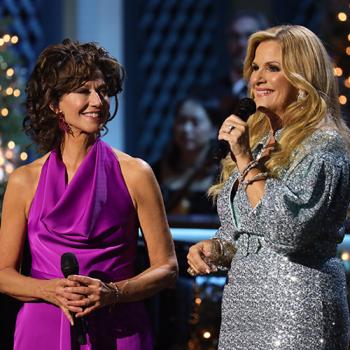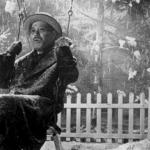Review of White Christmas, Directed by Michael Curtiz
By ALEXIS NEAL
Once upon a time, Bob Wallace and Phil Davis were in the Army together. On Christmas Eve in 1944, Davis (an aspiring performer) saved the life of Wallace (an established Broadway star) and the rest, as they say, is history. After the war, the two embark on a highly successful career culminating in the production of their own musical. Along the way, Wallace and Davis meet the charming Haynes sisters, Betty and Judy, and (at Davis’ insistence) they end up accompanying these lovely ladies to a certain inn in Vermont that just so happens to be run by General Waverly—Wallace and Davis’ old commanding officer. Things aren’t going so well for the general, however. It’s the middle of December and there’s nary a snowflake to be found. No snow on the slopes means no lodgers at the inn. The General is in danger of losing everything. Wallace and Davis decide to help out by doing what they do best: they’ll bring their show to the inn in an effort to drum up business. It’s a big job, to be sure, but Wallace and Davis are determined to save the day—and maybe win the hands of a few lovely maidens along the way.
This classic film boasts music by the legendary Irving Berlin, whose beloved ballad ‘White Christmas’ won him the Oscar for best song 12 years earlier in Holiday Inn (1942). That song, of course, appeared in White Christmas (1954), which netted Berlin another Oscar nod for best song, this time for ‘Count Your Blessings Instead of Sheep.’ White Christmas was originally intend to be yet another Crosby-Astaire-Berlin showcase, but Astaire passed on the script. Replacement Don O’Connor (of Singin’ in the Rain fame) dropped out for health reasons, and talented goofball Danny Kaye wound up with the part (much to my delight as a Kaye appreciator). Audiences must have liked the casting, as White Christmas was the top grossing film of 1954.
The story here is surprisingly devoid of any real focus on Christmas itself. The film take place in December and the big show is scheduled to open Christmas Eve, but other than that there’s really not much Christmas here (the iconic matching Santa robes in the closing scene notwithstanding).
Instead, the movie focuses on two sets of relationships: the budding romantic relationships between Wallace and Davis and the respective Haynes sister in whom each is interested (Bing opts for Rosemary Clooney; Kaye prefers the leggy—and dubbed—Vera Allen); and the relationship among the former members of the 151st Division, headed by General Waverly. The romantic relationships are pretty much par for the course—lots of silly miscommunications, overblown reactions, and unnecessary estrangements followed by heartfelt reconciliations. The relationships among the men are by far the more interesting.
The overall theme is one of continued connectedness, obligation, and sacrifice. On some level, this works itself out comically (as in Wallace’s continued sense of obligation to Davis for saving his life, and Davis’ shameless willingness to exploit that sense of obligation). But there are more serious implications as well. Wallace and Davis originally meet the Haynes sisters—who are trying to make a name for themselves in show biz—as a favor (of sorts) to an old Army pal. Wallace is able to enlist help from a television star in large part because they served in the Army together. Wallace and Davis undertake to move their entire show—cast, sets, and all—to rural Vermont to help out their old Army general. This is far from a low cost endeavor. It is nothing short of an act of personal sacrifice. And when Wallace exhorts his fellow veterans to come to Vermont to show appreciation for General Waverly, they do so. That they would leave their families on Christmas Eve, and at a moment’s notice, is evidence of a deep devotion to the General.
The interesting thing is that none of these individuals were supposed to have been terribly good friends. They do not do these things for one another because they knew each other terribly well, or even liked each other much. Time and time again, Wallace and Davis remind each other that they are doing this or that undesirable task ‘for a pal in the Army.’ The emphasis is clearly on ‘Army’, not ‘pal.’ The connection between them is not personal; it is based on a shared commitment to and service of a particular cause—a common experience that transcends personalities, professions, geography, and even time. On the strength of this connection, Wallace, Davis, and the other veterans of the 151st Division make costly sacrifices.
In some small way, this is a picture of life in the body of Christ. (We are in the Lord’s Army, after all.) Our shared believe in the atoning work of Christ and our common position as heirs through His blood unite us despite our differences. We should care for others in the church nut just because we like them or because they are our particular friends, but because we are members of one body. Paul reminds us that when one ‘member’ suffers, the whole body suffers. The well-being of all is thus commended to the care of each of us, and we are expected to help each other out for the sake of Him whom we serve.
And, as several characters constantly observe, care like this is only meaningful when it is undertaken selflessly—‘no angle,’ as they would say. To help another in order to help oneself is no great demonstration of love. Indeed, it is Betty’s perception that Wallace is trying to profit by the General’s misfortune that is at the root of their particular romantic misunderstanding. Only when she is convinced that Wallace is really truly trying to help the general without accruing any benefit to himself is her faith in him restored and their romantic bond reestablished.But the lessons of White Christmas are not limited to intra-church relationships. The film addresses the very nature of love itself. We know from scripture that caring for one another—loving each other—is not always easy. Paul admonishes us to ‘bear one another’s burdens’ (Galatians 6:2), to sacrifice our freedom rather than cause a brother to stumble (Romans 14; I Corinthians 8:7-14), and Jesus commands that we give to the poor and needy among us (Matthew 25:31-46). This kind of love is costly. And nowhere is the cost of love more clearly seen that in the life of Christ, who was made man for our sake, to live on our behalf the perfect life we could not live and by His death to pay the penalty we deserved. But love like this—love that is willing to sacrifice, to pay a price to serve the other—is the highest kind of love. It echoes the love our Savior showed us when he died in our place. ‘Greater love hath no man than this, that he lay down his life for his friends.’ (John 15:13) The men of the 151st Division—including General Waverly—risked their lives together to serve their country and protect freedom; it is fitting that they are now willing to sacrifice their comfort and—in the case of Wallace and Davis—significant expense in order to care for one of their own.
White Christmas may not be all that Christmas-y, as holiday movies go. There aren’t any reindeer and Santa is nowhere to be found. We don’t see even a dusting of snow until the final scene, and, apart from an oblique reference in ‘Count Your Blessings’, there is no mention of God or religion or the True Meaning of Christmas. But with its picture of selfless, sacrificial love, White Christmas has a lot more in common with the real Christmas story than we might think.
_______________________________________________________________
Alexis Neal is an attorney in the Washington, D.C., area. She regularly reviews young adult literature at www.childrensbooksandreviews.com and everything else at quantum-meruit.blogspot.com.












